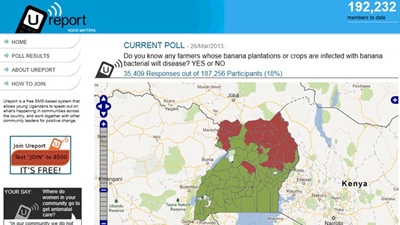Across Uganda's banana plantations, a devastating infection has been attacking the fruit, killing off entire crops and threatening food security. There are prevention methods to keep banana bacterial wilt (BBW) at bay, but the government faced a challenge: how to pinpoint the most vulnerable regions of the country and get prevention and treatment information into the hands of growers.
A team from the World Bank found an answer in open data built and spread by ICTs – information and communication technologies.
The project tapped into a system called Ureport – a network of 190,000+ volunteers across Uganda who use mobile technology to report on various issues of interest to UNICEF. Within days, the team was able to leverage Ureport to raise awareness, visualize the spread of the bacteria, and disseminate symptom descriptions and treatment options. More than 52,000 U-reporters either provided information about BBW, requested information, or both via SMS over the five days this spring.
"What Ureport made possible was not only information dissemination or data gathering, but a nationwide conversation focused on a critical issue for Ugandans," Lyudmila Bujoreanu, a World Bank ICT policy specialist, writes in a blog post describing the quick response in Uganda.
It also provided an example of fast data collection through ICTs that can help decision makers visualize crises as they develop and show them where and how best to respond. Similar data has been feeding into open data collections that today are using history, scientific knowledge, mapping, remote sensing, and real-time data collection to inform decisions and provide agriculture advice and warnings around the globe.
Exploring open data opportunities for agriculture
On April 29-30, the G8 International Conference on Open Data for Agriculture will bring together U.S. Agriculture Secretary Tom Vilsack, U.S. Chief Technology Officer Todd Park, World Bank Vice President for Sustainable Development Rachel Kyte, and experts in the field to explore more opportunities for open data and knowledge sharing that can help farmers and governments in Africa and around the globe protect their crops from pests and extreme weather, increase their yields, monitor water supplies, and anticipate changes brought on by climate change.
"We are already seeing the immense benefits of open data across the globe, but no more so than in Africa, and, specifically, agriculture data provides some of the most promise," said Chris Vein, senior manager for ICT at the World Bank.
"Imagine creating the ability for farmers to use open data to understand what crops grow best where, or what prices can be expected after harvest, or how best to solve weather, blight or other challenges to yield. Open data combined with other tools such as cellular phones can do just that," Vein said. "Through the World Bank's Open Development work, we are helping countries understand the potential value of their data, unlock that value by letting entrepreneurs inside and outside government use it, and create the tools necessary to empower citizens."

